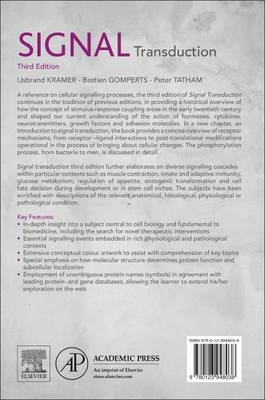
Signal Transduction
Academic Press Inc (Verlag)
978-0-12-394803-8 (ISBN)
Signal transduction third edition further elaborates on diverse signaling cascades within particular contexts such as muscle contraction, innate and adaptive immunity, glucose metabolism, regulation of appetite, oncogenic transformation and cell fate decision during development or in stem cell niches. The subjects have been enriched with descriptions of the relevant anatomical, histological, physiological or pathological condition.
Ijsbrand Kramer is a professor at the University of Bordeaux, working in the European Institute of Chemistry and Biology (IECB). He holds a Bachelors and Masters degree in BioMedicine from the University of Utrecht, The Netherlands, with a one year research-excursion in the Department of Cell Biology at the University of Liverpool, UK. He did his Ph.D. at the University of Amsterdam, in the Central Laboratory of Blood transfusion services (Stichting Sanquin) and worked as a post-doctoral fellow at the Hubrecht Laboratory in Utrecht and at the University of Washington in Seattle. He then took a lecturer position at the Department of Pharmacology at University College London, where he taught Signal Transduction (with Bastien Gomperts and Pether Tatham) and Pharmacology. Both teaching activities have been documented in textbooks: Signal Transduction (3 editions) and Receptor Pharmacology (CRC Press/Taylor Francis Group, 3 editions). Most of his research centers on the theme of inflammation, starting with neutrophils and the NADPH oxidase, synovial fibroblasts and destruction of the joint and more recently podosomes formation and extracellular matrix destruction in vascular endothelium. He moved to the University of Bordeaux for family reasons and switched from Pharmacology to Cell Biology, with a strong contribution to an introductory course for 1st year university students. Given the important teaching load and the general low level of student engagement in higher education he started to investigate the reasons for student failure (finding out about their expectations and attitudes) and the role of images and animations in comprehension. Scientific publications, web-based multimedia resources and dramatically enhanced retention rates (from 33 to 85%) are the fruits of these activities. At the same time he organized with University College London and Universitat Pompeu Fabra, Barcelona, summer schools on Receptor and Signalling Mechanism. He has been co-director of two European Programmes (Interbio and Transbio) that aimed at enhancing industrial innovation in the biomedical sector in the South West European Region (SUDOE). For book/publicity purposes, image of the author by Maarten Kramer
1. Prologue: Signal Transduction from a Historical Perspective2. An Introduction to Signal Transduction3. Regulation of Muscle Contraction by Receptors4. Cholinergic Signaling and Muscle Contraction5. Sensory Signal Processing; Visual Transduction and Olfaction6. Intracellular Calcium7. Bringing the Signal into the Nucleus: Regulation of Gene Expression8. Nuclear Receptors9. Protein Kinase C and Oncogenic Transformation and Cell Polarity10. Regulation of Cell Proliferation by Receptor Tyrosine Protein Kinases11. Signal Transduction to and from Adhesion Molecules12. WNT Signaling and the Regulation of Cell Adhesion and Differentiation13. Activation of the Innate Immune System: the Toll-Like Receptor-4 and Signaling through Ubiquitylation14. Chemokines and Traffic of White Blood Cells15. Activating the Adaptive Immune System: Role of Non-receptor Tyrosine Kinases16. Signaling through the Insulin Receptor: Phosphoinositide 3-Kinases and AKT17. TGFß and Signaling through Receptor Serine/Threonine Protein Kinases18. Protein Phosphates19. Cell Fate Determination by Notch
| Erscheint lt. Verlag | 31.12.2015 |
|---|---|
| Verlagsort | San Diego |
| Sprache | englisch |
| Maße | 152 x 229 mm |
| Gewicht | 1950 g |
| Themenwelt | Naturwissenschaften ► Biologie ► Biochemie |
| Naturwissenschaften ► Biologie ► Genetik / Molekularbiologie | |
| Naturwissenschaften ► Biologie ► Ökologie / Naturschutz | |
| ISBN-10 | 0-12-394803-7 / 0123948037 |
| ISBN-13 | 978-0-12-394803-8 / 9780123948038 |
| Zustand | Neuware |
| Haben Sie eine Frage zum Produkt? |
aus dem Bereich


